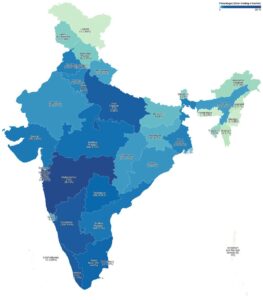Experts agreed that while the usage has still been patchy and stigmatised, sex toys were clearly becoming a bigger part of India’s sexual landscape.
Published Sep 10, 2025 | 7:00 AM ⚊ Updated Sep 10, 2025 | 4:04 PM

A nationwide survey revealed the emergence of states such as Telangana, Tamil Nadu, and Karnataka as hotspots of sex-toy awareness and use.
Synopsis: A recent study has revealed that the awareness and use of adult toys are on the upswing in South India. Though India doesn’t have specific laws on the sale and purchase of sex toys, many in South India are clandestinely buying them, thanks to the availability of disguised products such as lipstick vibrators, neck massagers, and pen-shaped toys. Online access (which ensures anonymity), open sex talk, helped in shattering cultural and societal mores that made sex — and toys — a taboo. Doctors are not miffed, since they see it as a healthy development.
South Indians are no longer as conservative as some Bollywood movies would love to portray. They have come of age — albeit silently — and are fast sh(r)edding the taboos that cultural and societal mores have imposed on them.
The result of a first-of-its-kind nationwide survey published in The Lancet Regional Health-Southeast Asia revealed the emergence of states such as Telangana, Tamil Nadu, and Karnataka as hotspots of sex-toy awareness and use.
While Maharashtra, the second-most populous state in India, led nationally in the use of sex toys with 35.7 percent, Telangana headed the southern states with 4.4 percent. Significant usage was reported from Tamil Nadu and Karnataka.
On the other end of the spectrum, several northeastern states and Ladakh barely registered, with usage as low as 0.1 percent to 0.3 percent.
“Sexual behavior in India has always been shaped by regional cultures,” explained Dr Pauras Mhatre, lead author of the study. “In South India, increasing urbanisation, access to online markets, and rising sex positive conversations are changing how people view sexual wellness.”
Sex toys are objects that are designed to induce or heighten sexual arousal. These devices play a crucial role in enhancing sexual pleasure, facilitating orgasms, as well as addressing medical conditions such as orgasmic dysfunction following cancer treatment.
However, the study argued that “Cultural attitudes significantly shape the discourse around this subject, often dictating the level of openness and acceptance within different communities,” Dr Mhatre noted.
Dr Mhatra of the Seth GS Medical College and KEM Hospital in Mumbai led a group of researchers from various departments in medical colleges and hospitals of Mumbai and Nagpur to fill a striking gap in sexual health research in India.

State-wise use of sex toys.
Despite the widespread cultural presence of sex toys globally, there has been little or no scientific data from India. “We used an online questionnaire to estimate the extent of sex toy use in Indian adults, explore user experiences, analyse the relationship between sex toy use and demographic factors, and examine the correlation between sex toy use and general sexual satisfaction,” the authors of the study said.
The researchers conducted a nationwide online survey among 2,071 Indian adults aged 18-44 years. The questionnaire was translated into multiple regional languages–including Marathi, Bengali, Telugu, Gujarati, Urdu, and Malayalam–to make it more inclusive and representative.
Respondents were asked about their awareness, use, experiences (both positive and negative), as well as the social and legal challenges they faced in accessing sex toys.
The methodology went beyond numbers and probed the social context. The team wanted to understand how cultural taboos, stigma, and accessibility shaped the use of sex toys. They also examined correlations between usage and satisfaction, gender identity, and sexual orientation.
By focusing on both statistical trends and lived experiences, the study aimed to offer a holistic picture of how Indians were navigating the world of sexual wellness in the face of conservative norms.
The study found that 98.5 percent of the respondents across the country acknowledged awareness about sex toys. It also revealed a heightened openness to sexual exploration and pleasure in Indian society despite conservative cultural norms. Yet only 40.56 percent admitted to actually using them.
The researchers found that “40.56 percent of participants in both solo and partnered sex reported use of sex toys,”
For 29-year-old Deepali Ram*, a marketing executive in Bengaluru, the gap reflected social stigma. “Everyone knows what a vibrator is. But not everyone dares to buy one. Even when I did, I told the courier guy it was a ‘massager’ just to avoid embarrassment,” she told South First.
While a significant number of participants reportedly shared positive experiences — highlighting the role of sex toys in understanding orgasms, promoting sexual arousal, and enhancing pleasure — some participants expressed negative experiences, such as feelings of inferiority, insecurities, and physical health issues. The usage was mainly hindered by primary concerns due to social taboos, fear of being judged, and challenges related to privacy, accessibility, and awareness.
“Recently, India has started making definitive strides in the direction of sexual literacy as reflected by the rising number of sex educators and sexual wellness influencers,” the study noted.
“In addition to offering a safe space to discuss intimacy, help rectify individuals’ perception of sex toys that promote and support safe, consensual, and playful sex for all genders and sexualities,” it added.
Despite these hurdles, South India’s strong numbers reflected a cultural shift.
While Telangana followed Maharashtra with 4.40 percent, which meant one in 23 people used a sex toy. In Tamil Nadu, 3.2 percent (about one in 31 people) used sex toys, while 2.9 percent in Karnataka (one in 34 people), 2.3 percent in Kerala one in 43 people and 1.9 percent in Andhra Pradesh (1 in 53 people) were exposed to sex toys.
In contrast, the northeastern states, including Nagaland (0.14%), Meghalaya (0.19%), and Mizoram (0.29%), along with Ladakh (0.19%), recorded negligible usage. This stark variation, the authors said, suggested that cultural comfort, urban exposure, and online accessibility heavily influenced how Indians interact with sexual wellness devices.
Meanwhile, experts argued that Maharashtra’s outlier status in the survey was likely a mix of factors rather than just a higher desire. Being one of India’s largest states, the experts argued that it probably had more respondents, especially from urban centres like Mumbai and Pune, where anonymity, online access, and exposure to global trends make buying sex toys easier.
Also, the study said that as part of the limitation was “Cultural attitudes significantly shape the discourse around the subject, often dictating the level of openness and acceptance with different communities.”
While the study numbers could indicate a lower percentage, sexual health counsellors and relationship counsellors South First spoke to agreed that many of their clients have sought suggestions on whether they could use sex toys.
“People openly talk about it. Some clients secretly get these toys and hide them from their partners. However, as long as it doesn’t come in between their natural sex and also they don’t get addicted to these, we don’t ask them to stop it,” Bengaluru-based sexual health counsellor and Dr Padmini Prasad said.
“Though many of these are not legally available in India, they do manage to get them somehow,” she added.
Dr Pramod Krishnappa, Consultant Uro-Andrologist at NU Hospitals said India was lacking in proper regulations, “which makes it difficult to access these even when medically required. The taboo around the use of these toys must go”.
The survey revealed a striking gender and identity divide: Cisgender women, queer individuals, and non-cisgender people were significantly more likely to use sex toys than straight men.
For many women, vibrators have been eye-openers. “I finally realised what an orgasm really feels like,” Preethi Goudar*, an HR manager in Chennai, said. “It made me more confident in my relationship too – I no longer feel guilty about wanting more,” she added.
The study noted that positive outcomes included “Understanding orgasms, promoting arousal and enhancing pleasure.”
Despite growing openness, the study noted that the legal system continued to frown upon this revolution.
“Currently, there is no explicit legal provision in India that bars the sale of sex toys,” the study noted, “But Section 292 of the Indian Penal Code (Section 294 of the Bharatiya Nyaya Sanhita) is frequently invoked to restrict their sale, import, or advertising on the grounds of obscenity.”
This loophole has forced companies to disguise products. Lipstick vibrators, “neck massager,” and pen-shaped toys dominate the market.
Arjun*, a 30-year-old from Hyderabad, often felt guilty as if he was indulging in a criminal act. “We buy the products clandestinely as if I am doing something criminal. But it’s just about pleasure, intimacy, and self-acceptance,” he said.
The survey also broke down usage by age. Adults aged 25-44 years were nearly twice as likely to use sex toys as those in the 18-24 bracket. The younger group reported high awareness but comparatively lower use – a sign of stigma and hesitation, said the study.
By contrast, older millennials and early Gen X respondents not only reported higher use but also more satisfaction, indicating greater confidence and autonomy in their sexual lives.
When it came to toys, vibrators were the most popular across both solo and partnered sex, thanks to their easy disguising as “massagers”. Dildos, cock rings, anal plugs, and BDSM accessories were reported in smaller numbers.
Interestingly, the data showed that cisgender women and queer respondents preferred vibrators and dildos, while men reported higher use of masturbation sleeves and cock rings. These preferences highlighted the gendered and identity-based ways Indians are experimenting with sex toys.
Doctors and people South First spoke to agreed that while the usage has still been patchy and stigmatised, sex toys were clearly becoming a bigger part of India’s sexual landscape–with states like Maharashtra, Telangana, and the southern belt leading the way.
The study also mentioned how sex educators and influencers, including the likes of Dr Cuterus (Dr Tanaya Narendra), acknowledged in the study, were helping young Indians navigate intimacy with less shame.
“Sex toys are not just about fun. They are about consent, safety, and equality in relationships,” clinical psychologist Dr Mahesh G said.
“For South India, which is often stereotyped as conservative, this data is proof that things can change faster than we anticipate. The toys are no longer whispered about in the bedroom. They are slowly – and quietly – becoming part of the mainstream,” he added.
(*Name changed. Edited by Majnu Babu).
